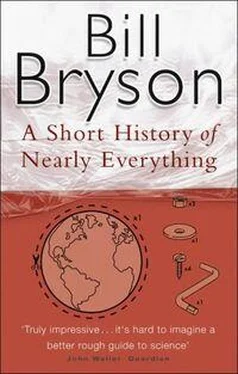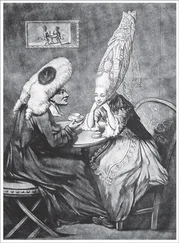But our purpose in mentioning him here is that in 1799, during a comparatively brief interlude in London, he founded the Royal Institution, yet another of the many learned societies that popped into being all over Britain in the late eighteenth and early nineteenth centuries. For a time it was almost the only institution of standing to actively promote the young science of chemistry, and that was thanks almost entirely to a brilliant young man named Humphry Davy, who was appointed the institution’s professor of chemistry shortly after its inception and rapidly gained fame as an outstanding lecturer and productive experimentalist.
Soon after taking up his position, Davy began to bang out new elements one after another-potassium, sodium, magnesium, calcium, strontium, and aluminum or aluminium, depending on which branch of English you favor. [13]He discovered so many elements not so much because he was serially astute as because he developed an ingenious technique of applying electricity to a molten substance-electrolysis, as it is known. Altogether he discovered a dozen elements, a fifth of the known total of his day. Davy might have done far more, but unfortunately as a young man he developed an abiding attachment to the buoyant pleasures of nitrous oxide. He grew so attached to the gas that he drew on it (literally) three or four times a day. Eventually, in 1829, it is thought to have killed him.
Fortunately more sober types were at work elsewhere. In 1808, a dour Quaker named John Dalton became the first person to intimate the nature of an atom (progress that will be discussed more completely a little further on), and in 1811 an Italian with the splendidly operatic name of Lorenzo Romano Amadeo Carlo Avogadro, Count of Quarequa and Cerreto, made a discovery that would prove highly significant in the long term-namely, that two equal volumes of gases of any type, if kept at the same pressure and temperature, will contain identical numbers of molecules.
Two things were notable about Avogadro’s Principle, as it became known. First, it provided a basis for more accurately measuring the size and weight of atoms. Using Avogadro’s mathematics, chemists were eventually able to work out, for instance, that a typical atom had a diameter of 0.00000008 centimeters, which is very little indeed. And second, almost no one knew about Avogadro’s appealingly simple principle for almost fifty years. [14]
Partly this was because Avogadro himself was a retiring fellow-he worked alone, corresponded very little with fellow scientists, published few papers, and attended no meetings-but also it was because there were no meetings to attend and few chemical journals in which to publish. This is a fairly extraordinary fact. The Industrial Revolution was driven in large part by developments in chemistry, and yet as an organized science chemistry barely existed for decades.
The Chemical Society of London was not founded until 1841 and didn’t begin to produce a regular journal until 1848, by which time most learned societies in Britain-Geological, Geographical, Zoological, Horticultural, and Linnaean (for naturalists and botanists)-were at least twenty years old and often much more. The rival Institute of Chemistry didn’t come into being until 1877, a year after the founding of the American Chemical Society. Because chemistry was so slow to get organized, news of Avogadro’s important breakthrough of 1811 didn’t begin to become general until the first international chemistry congress, in Karlsruhe, in 1860.
Because chemists for so long worked in isolation, conventions were slow to emerge. Until well into the second half of the century, the formula H 2O 2might mean water to one chemist but hydrogen peroxide to another. C 2H 4could signify ethylene or marsh gas. There was hardly a molecule that was uniformly represented everywhere.
Chemists also used a bewildering variety of symbols and abbreviations, often self-invented. Sweden’s J. J. Berzelius brought a much-needed measure of order to matters by decreeing that the elements be abbreviated on the basis of their Greek or Latin names, which is why the abbreviation for iron is Fe (from the Latin ferrum ) and that for silver is Ag (from the Latin argentum ). That so many of the other abbreviations accord with their English names (N for nitrogen, O for Oxygen, H for hydrogen, and so on) reflects English’s Latinate nature, not its exalted status. To indicate the number of atoms in a molecule, Berzelius employed a superscript notation, as in H 2O. Later, for no special reason, the fashion became to render the number as subscript: H 2O.
Despite the occasional tidyings-up, chemistry by the second half of the nineteenth century was in something of a mess, which is why everybody was so pleased by the rise to prominence in 1869 of an odd and crazed-looking professor at the University of St. Petersburg named Dmitri Ivanovich Mendeleyev.
Mendeleyev (also sometimes spelled Mendeleev or Mendeléef) was born in 1834 at Tobolsk, in the far west of Siberia, into a well-educated, reasonably prosperous, and very large family-so large, in fact, that history has lost track of exactly how many Mendeleyevs there were: some sources say there were fourteen children, some say seventeen. All agree, at any rate, that Dmitri was the youngest. Luck was not always with the Mendeleyevs. When Dmitri was small his father, the headmaster of a local school, went blind and his mother had to go out to work. Clearly an extraordinary woman, she eventually became the manager of a successful glass factory. All went well until 1848, when the factory burned down and the family was reduced to penury. Determined to get her youngest child an education, the indomitable Mrs. Mendeleyev hitchhiked with young Dmitri four thousand miles to St. Petersburg-that’s equivalent to traveling from London to Equatorial Guinea-and deposited him at the Institute of Pedagogy. Worn out by her efforts, she died soon after.
Mendeleyev dutifully completed his studies and eventually landed a position at the local university. There he was a competent but not terribly outstanding chemist, known more for his wild hair and beard, which he had trimmed just once a year, than for his gifts in the laboratory.
However, in 1869, at the age of thirty-five, he began to toy with a way to arrange the elements. At the time, elements were normally grouped in two ways-either by atomic weight (using Avogadro’s Principle) or by common properties (whether they were metals or gases, for instance). Mendeleyev’s breakthrough was to see that the two could be combined in a single table.
As is often the way in science, the principle had actually been anticipated three years previously by an amateur chemist in England named John Newlands. He suggested that when elements were arranged by weight they appeared to repeat certain properties-in a sense to harmonize-at every eighth place along the scale. Slightly unwisely, for this was an idea whose time had not quite yet come, Newlands called it the Law of Octaves and likened the arrangement to the octaves on a piano keyboard. Perhaps there was something in Newlands’s manner of presentation, but the idea was considered fundamentally preposterous and widely mocked. At gatherings, droller members of the audience would sometimes ask him if he could get his elements to play them a little tune. Discouraged, Newlands gave up pushing the idea and soon dropped from view altogether.
Mendeleyev used a slightly different approach, placing his elements into groups of seven, but employed fundamentally the same principle. Suddenly the idea seemed brilliant and wondrously perceptive. Because the properties repeated themselves periodically, the invention became known as the periodic table.
Mendeleyev was said to have been inspired by the card game known as solitaire in North America and patience elsewhere, wherein cards are arranged by suit horizontally and by number vertically. Using a broadly similar concept, he arranged the elements in horizontal rows called periods and vertical columns called groups. This instantly showed one set of relationships when read up and down and another when read from side to side. Specifically, the vertical columns put together chemicals that have similar properties. Thus copper sits on top of silver and silver sits on top of gold because of their chemical affinities as metals, while helium, neon, and argon are in a column made up of gases. (The actual, formal determinant in the ordering is something called their electron valences, for which you will have to enroll in night classes if you wish an understanding.) The horizontal rows, meanwhile, arrange the chemicals in ascending order by the number of protons in their nuclei-what is known as their atomic number.
Читать дальше












